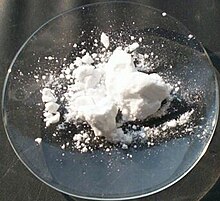Sodium phosphate
| Structural formula | ||||||||||
|---|---|---|---|---|---|---|---|---|---|---|

|
||||||||||
| General | ||||||||||
| Surname | Sodium phosphate | |||||||||
| other names |
|
|||||||||
| Molecular formula | Na 3 PO 4 | |||||||||
| Brief description |
white odorless solid |
|||||||||
| External identifiers / databases | ||||||||||
|
||||||||||
| Drug information | ||||||||||
| ATC code | ||||||||||
| properties | ||||||||||
| Molar mass | ||||||||||
| Physical state |
firmly |
|||||||||
| density |
1.62 g cm −3 (dodecahydrate) |
|||||||||
| Melting point |
|
|||||||||
| pK s value |
pK b : 1.64 |
|||||||||
| solubility |
easily in water (285 g l −1 at 20 ° C, dodecahydrate) |
|||||||||
| safety instructions | ||||||||||
|
||||||||||
| As far as possible and customary, SI units are used. Unless otherwise noted, the data given apply to standard conditions . | ||||||||||
Sodium phosphate is a sodium salt of phosphoric acid . It consists of sodium (3 Na + ) and phosphate ions (PO 4 3− ).
Extraction and presentation
Sodium phosphate can be produced by neutralizing phosphoric acid with sodium hydroxide . This does not necessarily have to be done in an aqueous medium.
properties
Sodium phosphate forms colorless crystals. Sodium phosphate has a basic reaction in aqueous solution because the basic phosphate ion is protonated . The pH of a ten percent solution is 11.8-12.2.
The compound occurs in several modifications, such as a tetragonal [α], orthorhombic [β] and orthorhombic (pseudocubic) [γ] form. The α-form arises below 600 ° C (a = 10.757 and c = 6.824 Å ). The γ-form arises between 700 ° C and 800 ° C (a = 5.237, b = 5.203 and c = 7.400 Å) and has a crystal structure with the space group Pnma (space group no. 62) . The previously uncharacterized β-form seems to be an intermediate product in the α → γ and γ → α changes and was always obtained in a mixture with the α or γ form. Their structure is closely related to that of β- sodium arsenate Na 3 AsO 4 .
use
Phosphates are used as additives in detergents . They are capable of complex formation with multivalent metal ions (Mg 2+ which etc.) Hardness reduced. Their use is now banned in some countries (including Switzerland ). Under the name “trisodium phosphate”, sodium phosphate is used in the operation of steam boilers and heating water circuits as a dosing solution in order to soften the content water and at the same time to alkalize it ( corrosion protection ). A three to five percent solution (3–5 kg / 100 l) is prepared in a dosing container. The metering is expediently carried out by means of a metering pump into the feed water tank , if necessary into the condensate tank . The amount of filling water added in heating systems depends on the hardness and the amount of filling water. For 1 m³ of filling water at 0.18 mol / m³ = 1 ° dH , 68 grams of trisodium phosphate are added.
Example:
- Refill quantity of a heating system: 0.8 m³
- Filling water - GH 2.14 mol / m³ = 12 ° dH
- Amount of trisodium phosphate = refill amount [m³] times [° dGH] times 68 [g] = 0.8 × 12 times 68
- Amount of trisodium phosphate added = 650 g
It is expediently added to the heating return by means of a metering pump or a chemical feed sluice.
In food technology, sodium phosphate is used as a complexing agent , acid regulator , melting salt or setting agent. Together with sodium dihydrogen phosphate and disodium hydrogen phosphate, it is approved in the EU as a food additive under the common number E 339 ("sodium phosphate") for certain foods, each with different maximum quantity restrictions. According to the Additive Admissions Ordinance , these are - largely uniform for most of the approved phosphates - individual specifications for a wide range of numerous different types of food. The maximum permitted amounts vary from 0.5 to 50 grams per kilogram (in creamer for vending machines) or the lack of a fixed limit ( quantum satis - as required, for food supplements and sometimes for chewing gum).
Phosphates are also used as artificial fertilizers .
The radioactive 32 phosphorus is used as sodium phosphate (or dihydrogen phosphate ) for nuclear medicine therapy in polycythemia vera ( radiophosphorus therapy ).
Biological importance
The consequence of the use of phosphates in detergents is a greater supply of nutrients in water . This results in increased algae growth , which can lead to the overturning of a body of water.
Individual evidence
- ↑ a b c d e f g h Entry on trisodium phosphate in the GESTIS substance database of the IFA , accessed on January 10, 2017(JavaScript required) .
- ↑ Entry on phosphoric acid. In: Römpp Online . Georg Thieme Verlag, accessed on May 29, 2014.
- ↑ M. Kizilyalli, AJE Welch: Preparation and X-ray powder diffraction data for anhydrous sodium orthophosphates. In: Journal of Inorganic and Nuclear Chemistry. 38, 1976, p. 1237, doi : 10.1016 / 0022-1902 (76) 80127-3 .






